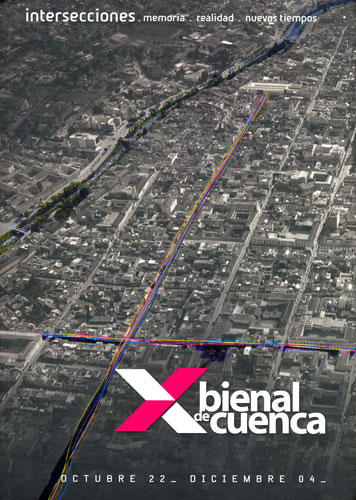
INTERSECTIONS - INTERACTIONS
Gustavo Ortíz, Colombian Curator, Contemporary Art Museum of Bogotá Director
To activate the urban environment as stage for permanent encountering between its natural actors: the citizens.
Meeting places, mutually attracted trajectories, parallel universes, merging memories, welded gazes, sweat of poetry, delta of ideas.
***
One day like any other day, an Ecuatorian Indian dresses as a Redskin Indian to perform as human statue in Las Ramblas of Barcelona. Is summer time, and tourists from all over Europe come downwards to the Mediterranean coasts, and especially to the Spanish coast, to warm them up.
La Rambla, a dry riverbed, is the perfect setting for the intersection of many cultures, the meeting point of personal and collective imaginaries. Streams of people pass by looking for a photo, a friend, a store, handicrafts, books, music, food, air, earning, surprise, shadow, refreshment… Each one wanders apparently adrift in a dance that reminds the dancing of bees around the honey.
We could say that Honey, that viscose liquid, transparent and sweet, healing and merging, resembles culture a lot. It is an extract, a synthesis of bee saliva and flower nectar, transported through large distances, extracted from many plants, swallowed and mixed with a thousand flavors, comes to the palate to satisfy the tasting papilla, to overwhelm the smelling sense with its fragrance to finally find its way towards the digestive labyrinth. Honey must be tasted with closed eyes.
The Redskin has been forced by virtue of westerns to become an icon of the native American whose shadow seems to darken the diversity of the other native groups living in our immense continent. The stereotype becomes the systemic archetype that interferes perception by producing such a conceptual noise.
Why does an Ecuatorian Indian must play Redskin to survive or to attract audiences? Are we witnessing a case of identity theft where forging, simulating or mimicking an original product at such a low-price permits to gain a slice of the market of cultural consumption? Is it a consequence of hybridization, of a media graft? If he were just to wear his traditional costume as an Ecuatorian Indian would he attract as well? Difference can be vindicated only by means of simulations?
A few blocks down one find a Ché Guevara with the whole attire, smoking his tobacco, who smiles and with his hands makes a gesture that could be interpreted as a peace sign or as the sign of victory. Dressed in his kaki uniform he pleases innumerable groups of tourists who wish a picture with him, be it smoking the unlit tobacco, or with his arm raised and the fist closed as a sign of battle, or just smiling while making a military salute.
Roads and Concepts intersect again, a revolutionary icon is resemantized to turn him in a product of cultural consumption, a failed longing experienced by the masses that flow through the Rambla, and as pilgrims arrive to the already set altars along the way to worship the emblematic figured enthroned by mass media.
What attracts them is the art of simulation, the need for icons that will make their parallel universes converge, it is the offer of a souvenir that will suit the demand of anecdotes and of the picture.
One lives and survives as a human statue, increasingly turn into the characters they perform, by studying them and going deeper and deeper into their identities.
Where does one identity remain? Or, it is precisely the effort to identify with the archetype what breaks the stereotype? Must one be so flexible as to assume other identities as a condition for surviving in the hypermedia XXI century?
All these reflections aroused by these intersections would not be possible without one interaction, that is to say, if statues were just that: statues.
Monuments are no attractive to new generations. When witnessing a tribute paid to the Redskin Indian or to the Ché Guevara it is most likely that the hordes of tourists just pass by or a flock of doves leaves its detritus; but when the statue becomes alive the relationship changes altogether, the scale is sharply reduced, and despite the effort the actors make to remain mute, their actions, gestures, and sounds, create a fluid semiotic transaction with the passer by.
Transgression becomes equivalent in this situation to negotiation. To intersect is to succeed in fracturing the circuit to allow the entrance of new ideas to relate in a asymmetric field dominated by the hurricane winds of globalization.
|

